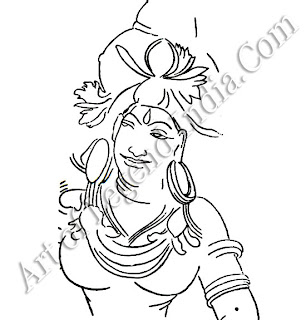 The
paintings at Tiruvanchikulam, at Pallimanna, at Triprayer, in the Vadakkunatha
temple at Trichur and in the Mattancheri palace constitute a rich heritage from
the Cochin area, while those from Vaikom, Ettumanur, Chitaral, etc., having a
culmination in the famous paintings from the Padmanabhapuram and Krishnapuram
palaces, provide a picture of the painter's art in Travancore area. The mouth
is rather wide and the eyes have side-long looks, the body-build is heavy and a
smile is evident on the lips of all the figures of this school. Minute details
of dress and habits can be studied here. The top-knot of the Nambudiris and the
triple lamp so common in Malabar are all present. The scenes from the Ramayana,
the Mahabharata and the Puranas, including iconographic themes chosen by the
painters for portrayal, like the incident of Kumbhakarna gobbling the monkeys so
tiny as to escape through his nostrils and ears, are examples of the painters'
novel choice of comparatively insignificant but nevertheless interesting
scenes.
The
paintings at Tiruvanchikulam, at Pallimanna, at Triprayer, in the Vadakkunatha
temple at Trichur and in the Mattancheri palace constitute a rich heritage from
the Cochin area, while those from Vaikom, Ettumanur, Chitaral, etc., having a
culmination in the famous paintings from the Padmanabhapuram and Krishnapuram
palaces, provide a picture of the painter's art in Travancore area. The mouth
is rather wide and the eyes have side-long looks, the body-build is heavy and a
smile is evident on the lips of all the figures of this school. Minute details
of dress and habits can be studied here. The top-knot of the Nambudiris and the
triple lamp so common in Malabar are all present. The scenes from the Ramayana,
the Mahabharata and the Puranas, including iconographic themes chosen by the
painters for portrayal, like the incident of Kumbhakarna gobbling the monkeys so
tiny as to escape through his nostrils and ears, are examples of the painters'
novel choice of comparatively insignificant but nevertheless interesting
scenes.
In the
Chera country, there was great temple-building activity during the Vijayanagara
period and the temple of Sthanunatha at Suchindram and the Padmanabhasvami
shrine at Trivandrum have had a good deal of additions and embellishments
during this period till practically the eighteenth century. The peculiar local
type of plan and super-structure may be noticed at Tirunandikkarai and
Trikotithanam where the single and double-roofed circular shrines,
respectively, represent an individualistic pattern peculiar to Malabar. Though
very little has yet been discovered to show the intermediate stages between the
early Chera phase at Tirunandikkarai and the late period, there are yet lovely
paintings at Tiruvanchikulam that suggest the march of Chera painting in the Kerala
country towards the phase that corresponds to the Vijayanagara and the Nayak
periods in the Tamil South.
The
Chera school closely resembles the contemporary sculpture and wood carvings
but, up to the early Vijayanagara period, little has been found to show the
intermediate stages. With a distinctive type of anatomy of squat and robust
type of figures, peculiar rich ornamentation recalling the Kathakati make-up,
they present a subtle combination of the Kanarese and Dravida types easily seen
in the peculiar elongate halo surrounding the crown as in Western Chalukya
figures and other details. The nandidhvaja in one of the hands of the
multi-armed Siva Nataraja on Apasmara at Ettumanur recalls both the Badami and
Pattadaskal Natesas as well as the Nallur one. It is interesting to see how
closely it resembles a similar painting from the Kailasa temple at Ellora. This
huge painting that can vie with the earlier Chola Tripurantaka panel at
Tanjavur and with the contemporary Vijayanagara Virabhadra at Lepakshi is a
remarkable one located in the temple gopura and forms a fine introduction to
the genius of the painter in Malabar at this period of history.
 The
paintings at Tiruvanchikulam, at Pallimanna, at Triprayer, in the Vadakkunatha
temple at Trichur and in the Mattancheri palace constitute a rich heritage from
the Cochin area, while those from Vaikom, Ettumanur, Chitaral, etc., having a
culmination in the famous paintings from the Padmanabhapuram and Krishnapuram
palaces, provide a picture of the painter's art in Travancore area. The mouth
is rather wide and the eyes have side-long looks, the body-build is heavy and a
smile is evident on the lips of all the figures of this school. Minute details
of dress and habits can be studied here. The top-knot of the Nambudiris and the
triple lamp so common in Malabar are all present. The scenes from the Ramayana,
the Mahabharata and the Puranas, including iconographic themes chosen by the
painters for portrayal, like the incident of Kumbhakarna gobbling the monkeys so
tiny as to escape through his nostrils and ears, are examples of the painters'
novel choice of comparatively insignificant but nevertheless interesting
scenes.
The
paintings at Tiruvanchikulam, at Pallimanna, at Triprayer, in the Vadakkunatha
temple at Trichur and in the Mattancheri palace constitute a rich heritage from
the Cochin area, while those from Vaikom, Ettumanur, Chitaral, etc., having a
culmination in the famous paintings from the Padmanabhapuram and Krishnapuram
palaces, provide a picture of the painter's art in Travancore area. The mouth
is rather wide and the eyes have side-long looks, the body-build is heavy and a
smile is evident on the lips of all the figures of this school. Minute details
of dress and habits can be studied here. The top-knot of the Nambudiris and the
triple lamp so common in Malabar are all present. The scenes from the Ramayana,
the Mahabharata and the Puranas, including iconographic themes chosen by the
painters for portrayal, like the incident of Kumbhakarna gobbling the monkeys so
tiny as to escape through his nostrils and ears, are examples of the painters'
novel choice of comparatively insignificant but nevertheless interesting
scenes.
Writer
– C. Shivramamurti
Subscribe to:
Post Comments (Atom)












0 Response to "Medieval Kerala`s"
Post a Comment